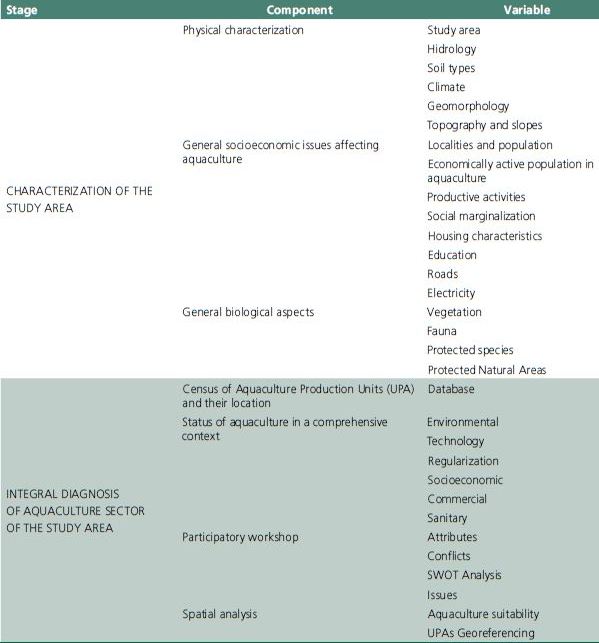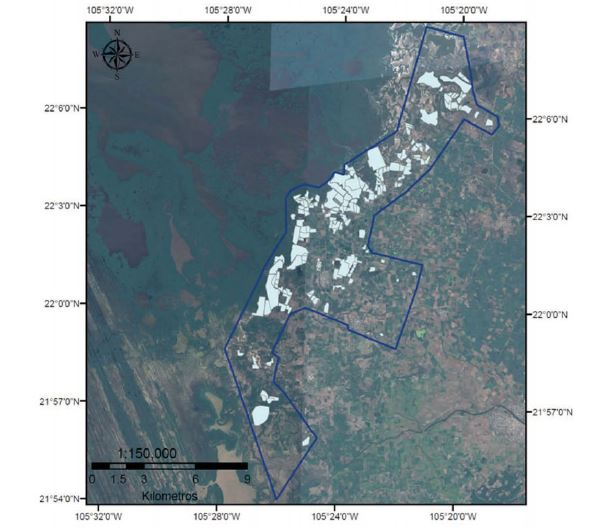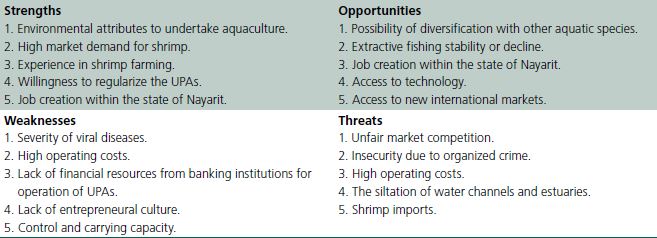3 METHODOLOGY
The National Aquaculture Management Program (PNOA—Spanish acronym) is carried out through the implementation of aquaculture projects at state levels, pointing out the need to include educational institutions such as universities and research centers or private consultancies with expertise in aquaculture matters, which would provide the appropriate tools in order to facilitate decision-making. CESANAY was responsible for the execution of the present case study.
The proposed aquaculture management program for shrimp farming in the area of the P-P Nayarit study initially consists of two stages: (i) characterization of the study area, and (ii) comprehensive assessment of the aquaculture sector of the study area. These stages are governed by four components and 30 variables (Table 1) which must be determined by bibliographical research, application of polygons and images, attribute tables, surveys and participatory workshops.
Enough information resulting from close coordination among CONAPESCA and SEMARNAT was obtained based on the characterization and diagnosis stages; it was used to prepare a proposal for the regularization of shrimp aquaculture UPAs, as well as to obtain the following documents:
1. CONAPESCA: (i) National Registry of Fisheries and Aquaculture (RNPyA—Spanish acronym).
2. SEMARNAT: (i) Use of surface waters, (ii) Surface water disposal, (iii) Resolution regarding environmental assessment, (iv) Concession over federal maritime terrestrial zone* and (v) Permit for land use change*.
*If applicable
Table 1. Terms of Reference for an Aquaculture Management Project.

3.1 Characterization of Study Area P-P, Nayarit
3.1.1 Physical Characterization
Study Area: Located on the coastal plain of the northern part of the state of Nayarit, the total surface of the study area P-P is 11,845 hectares. The extreme coordinates are: 22º 09’ 11” north, 21° 57’ 06” south, 105° 21’ 01” east and 105° 26’ 30” west. It was defined taking into account the water body (marsh), its proximity to towns, highways and rural roads, as well as the distribution of operating UPAs, using ArcGIS 10 (Figure 2).
Hydrology: The study area is located in the basins of the Acaponeta River and the San Pedro River, draining fresh water. These rivers have a markedly seasonal
Figure 2. Boundaries of the study area in the State of Nayarit, Mexico.

behavior and are found within the Teacapan-Agua Brava lagoon system, which records seasonal salinity variability, showing big contrasts between drought and rainfall seasons; greater variation happens in rainfall (Sánchez, 1994). Salinity drops sharply to 8 percent in autumn during the rains, and reduces to 0 percent in the lagoon and its tributaries (Alvarez et al., 1986).
Low temperature values (23°C) were recorded during winter, while higher values were recorded (32°C) during spring.
Soil types: Eutric Cambisol, Solonchak, gleyic and Solonchak, orthic.
Climate: Warm weather prevails in the coastal area with a highest annual average temperature of 25°C, classified as humid warm with summer rains of medium humidity. Maximum temperature is 33.9°C and minimum is 17.9°C.
Geomorphology: The study area is mainly coastal brackish lagoons and delta plains.
Topography and land slope: The study area has flat soils with average slopes below 2 percent and it is thus suitable for aquaculture.
3.1.2 General Socioeconomic Issues Affecting Aquaculture
Localities and population: The total population of the study area is 8,105 inhabitants (INEGI, 2010), living in 7 localities that support shrimp aquaculture in the region.
by SAGARPA-CONAPESCA. Only the semi-intensive system is employed, having moderate stocking densities of 8–15 org/m2. The UPA’s operative infrastructure includes 311 earthen ponds with dikes irregularly shaped. Ponds are fed surface waters from adjacent estuaries and coastal lagoons. 67 percent of the UPAs is productive only once a year during the summerwinter season, while 33 percent of the units carry out two production cycles per year (winter-spring and summer-autumn). The UPAs undertake a range of activities for production:
• Pond preparation.
• Pond water filling.
• Acclimatization and stocking.
• Feeding.
• Water quality and biometrics monitoring.
• Harvesting.
Regularization status: Due to technical and policy ignorance, UPAs have been created with no order or legal compliance, resulting in disorderly growth of aquaculture in this region. Within the study area, none of the UPAs comply with legal regulations due to:
• Ignorance of the legal framework and current regulations.
• The scarcity of resources only allows stakeholders to build their aquaculture facilities.
Economically active population in aquaculture:
3,203 people, 86.73 percent male and 13.27 percent female.
Productive activities: Productive activities are mostly agricultural. Agriculture is the activity that demands the most jobs; it is followed by livestock and fisheries.
Social exclusion (marginalization): According to social standards (based on insufficient access to social rights, material deprivation, limited social participation and a lack of normative integration), the study area is considered as “medium” in social exclusion.
Housing conditions: Within the study area, 2,267 houses are inhabited, none of which have dirt floors; 2,306 have electricity connection, 2,226 have sewage and 2,250 have piped water.
Education: Within the study area there are educational preschool, primary, secondary and high school facilities.
Roads: Good paved roads lead to the localities, but access to UPAs is by dirt roads in bad conditions, which worsen during the rainy season.
Electricity: The localities are connected to power lines; however, there is a lack of lines in the area where the UPAs are located.
3.1.3 General Biological Issues
Vegetation: The main vegetation is low thorny deciduous forest and mangrove.
Fauna: In the study area, wildlife is virtually nonexistent due to the proximity of human settlements and economic activities, mainly fisheries and aquaculture.
However, in the National Wetlands in Nayarit, which adjoins the study area, 240 species of vertebrates have been reported, 60 of which are under protected status. The presence of two native aquatic species (white shrimp and mangrove oyster) and one exotic species (Tilapia) within the area is noteworthy; their cultivation is feasible.
Protected species: The Mexican norm NOM-059-SEMARNAT-2010 aims to identify species or wildlife populations at risk in Mexico; 14 species within this norm have been identified in the study area.
Protected Natural Areas (ANP): The study area adjoins the protected natural area known as the Nayarit National Marshes Biosphere Reserve, which comprises the municipalities of Acaponeta, Rosamorada, Santiago Ixcuintla, Tecuala and Tuxpan in the state of Nayarit.
3.2 Integral Diagnosis of Aquaculture in the Study Area P-P, Nayarit
With information derived from the participatory workshop as well as bibliographical research on the P-P, Nayarit, the following conclusions were reached:
3.2.1 C ensus of Aquaculture Production Units (UPA) and Location
163 shrimp production farm units were identified; production was estimated at around 1,600 tonne.
Shrimp aquaculture farms generate 583 permanent and 1,237 temporary jobs. There are 481 direct beneficiaries from the project, who are members of the UPAs and 2,290 indirect beneficiaries, both permanent and temporary workers. The total area involved in shrimp aquaculture farms within the study area is 2,263.26 ha while the productive area is 1,964.20 ha.
3.2.2 C onditions of Aquaculture in a Comprehensive Context
Environmental conditions: The study area is an important conservation region due to the high concentration of aquatic fowl as well as migratory or semiaquatic residents, vertebrates and endemic insects. It has a large extension of well-preserved mangroves. It is limited by the mangrove areas and the water bodies.
The following environmental problems have been identified, caused by anthropogenic activities:
• Destruction of mangroves and wetlands.
• Unplanned development for shrimp farming on a large scale.
• Salinization of agricultural land.
• Silting of estuaries and pumping channels. Technological conditions: Producers lack the necessary resources to technologically upgrade and develop their production units. Since 100 percent of the UPAs is legally irregular, they cannot access financial support from federal programs handled
• Few extension technicians provide technical assistance to support those interested in initiating an aquaculture project within the legal framework.
• High cost of assessment studies required for the application procedures for some permits.
• Difficulty and time to obtain the required permits and licences for shrimp farming.
Socioeconomic conditions: There are 473 shrimp aquaculture stakeholders in the study area. 419 are male (89 percent), and 54 are female (11 percent). Currently there are 575 permanent and 1,213 temporary jobs.
Commercial conditions: Marketing is usually done by producers, whole, fresh at the UPA farm gate; nonetheless, the State of Nayarit has processing plants that add value to shrimp production (frozen with head, in blocks with head, dried with head).
Health conditions: The Nayarit State Aquatic Health Committee (CESANAY—Spanish acronym) is responsible for monitoring the sanitary conditions of UPAs in the study area. Visits are made to the various shrimp aquaculture production units, with the aim of monitoring the organisms’ health through various laboratory tests. UPAs utilize bactericides such as Onmicron and Timsen. When a sanitation problem arises, a sanitary protocol is implemented for stocking, on-growing, harvesting and post-harvest of shrimp. There is an official agreement in place for a sanitary dryout in the UPAs lasting from December 1st to the last day of February, aimed at reducing mortalities caused by the white spot disease.
The following diseases have occurred in the study area: White spot viral disease, the Taura virus, and IHHNV virus. Since 2013, atypical mortalities have been reported related to acute hepatopancreatic necrosis syndrome at the initial stages of shrimp cultivation.
3.2.3 Participative Workshop/Meeting
A participative workshop was held on December 16th, 2013, starting at 10:00 am, at the facilities of the Ejido Commissary of Pimentillo. It was organized by the project executor (CESANAY) in order to assess key environmental attributes, conflicts with other sectors, a SWOT analysis of aquaculture in the study area, and the issues presented by the aquaculture sector on the site. 43 people attended the workshop, including 33 farmers from the study area and 10 aquaculture technicians responsible for the UPAs surveyed.
Environmental attributes: The shrimp farmers operating in the study area identified five essential environmental attributes2 (Table 2) for shrimp aquaculture; water availability being the most important.
Conflicts: Shrimp aquaculture in the study area faces four conflicts with the following sectors: (i) agriculture,
2 Only environmental attributes were considered at this stage of the analysis, having been prioritized and included in the spatial analysis. Social and economic factors were included in the conflicts, in the SWOT analysis, and under issues. Governance was evaluated in the UPAs survey (legal and document status) but this information was only included in the diagnosis report.
Table 2. Environmental attributes for shrimp aquaculture in Nayarit State, Mexico.
(ii) fishing, (iii) conservation-forest, and (iv) human settlements. The greatest conflict is with agriculture, and particularly in relation to shrimp aquaculture, due to the use of agrochemical fertilizers and pesticides which drain to water bodies as well as unlimited use of water by farmers. Another important conflict is with the fishing sector striving for the use of environmental resources since both activities are developed in the same area.
SWOT Analysis: The SWOT analysis enabled the identification of five main strengths, weaknesses, opportunities, and threats faced by shrimp aquaculture in the study area.
Issues: Five main problems affecting shrimp aquaculture development in this region were emphasized by shrimp producers:
1. Lack of links with research centers.
2. Insufficient capacity of the cold chain.
3. High cost of feed and of high quality larvae.
4. Dissemination of viral diseases.
5. Silting of the estuaries and of water channels.
3.2.4 Spatial Analysis
One of the main objectives of Geographical Information Systems is to facilitate the decision making. The systems incorporate algorithms to assess simple,
Table 3. SWOT matrix designed at the participative workshop/meeting.
multiple, and multi-criteria objectives interacting with the criteria and knowledge of the group of experts involved in the project of aquaculture management (CONAPESCA—CESANAY).
The spatial analysis in this case study aims to determine the portion or portions of the total surface area that meet a set of weighed criteria. Heuristics is used to solve conflicts with massive sets of data.
Each criterion to be met is addressed through the classification of thematic information layers to create abstract territorial models; these layers were obtained through a bibliographical survey at the diagnosis stage. Each layer is assessed and reclassified at different points of the methodology stated for each aptitude model, verifying for possible conflicts, and looking for the best solution using a minimum distance rule with weighed values.
When building each model, criteria for definition of aptitude for shrimp aquaculture were established as factors and restrictions. Later, they were spatially represented by subject matters according to each factor or restriction.
Multi-criteria evaluation (Eastman et al., 1993; Aguilar-Manjarrez, 1996; Malczewski, 1999) allowed the interaction of all factors simultaneously, without having to perform several overlay map operations, nor modifying attribute values by a constant value, nor a final reclassification of the end map resulting from a combination of all layers of the information process.
The maps resulting from the multi-criteria evaluation showed the importance that the factors with the highest assigned weights had, which exerted the greatest influence in determining the areas with the greatest potential.
ArcGIS 10 software was used for this case study. The sets of data were expressed in a vectorial format which may be integrated into any commercial or free geographic information software. The output data sets were:
• Georeferencing of UPAs.
• Aptitude for aquaculture by species (shrimp).
Both UPAs and the study area P-P, Nayarit, were georeferenced using information generated by the project executor (CESANAY) from the survey Census of Aquaculture Production Units (UPAs) and their conditions.
Moreover, for determining the aquaculture aptitude areas, environmental information from the National Institute of Statistics and Geography (INEGI) was used for the following variables: soil types, hydrology, geomorphology, topography and slope, localities and population, roads, electricity, and Natural Protected Areas. Later, thresholds were determined to state the aptitude for shrimp aquaculture and the priority of each variable through a multi-criteria analysis based on consultation with experts, bibliography, and the results of the participatory workshop/meeting (environmental attributes). The other variables (Table 1) were used for the integral diagnosis report.
3.2.4.1 UPAs Geo-referencing of UPAs
The Census of Aquaculture Production Units (UPAs), and their conditions, were established based on the information generated from the diagnosis stage; then the 163 UPAs identified were delimited along with their table of attributes (Figure 3).
3.2.4.2 Aquaculture Aptitude (Shrimp)
Geographic Information Systems were used for the determination of shrimp aquaculture aptitude in the study area based on the results of the spatial analysis (Figure 4) and the coverage area was determined for each aptitude (Table 4).
Once the suitability of shrimp aquaculture in the study area was determined, it became clear that new UPAs may be developed in a surface of 3,741.59 hectares.
However, this growth must comply with current legislation for an orderly growth of aquaculture.